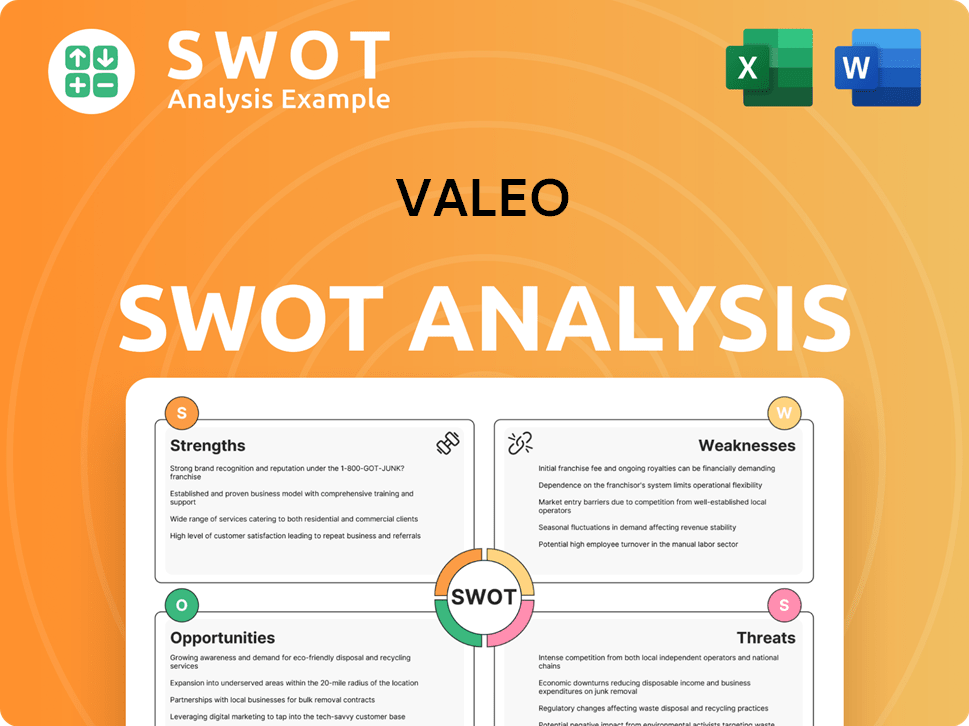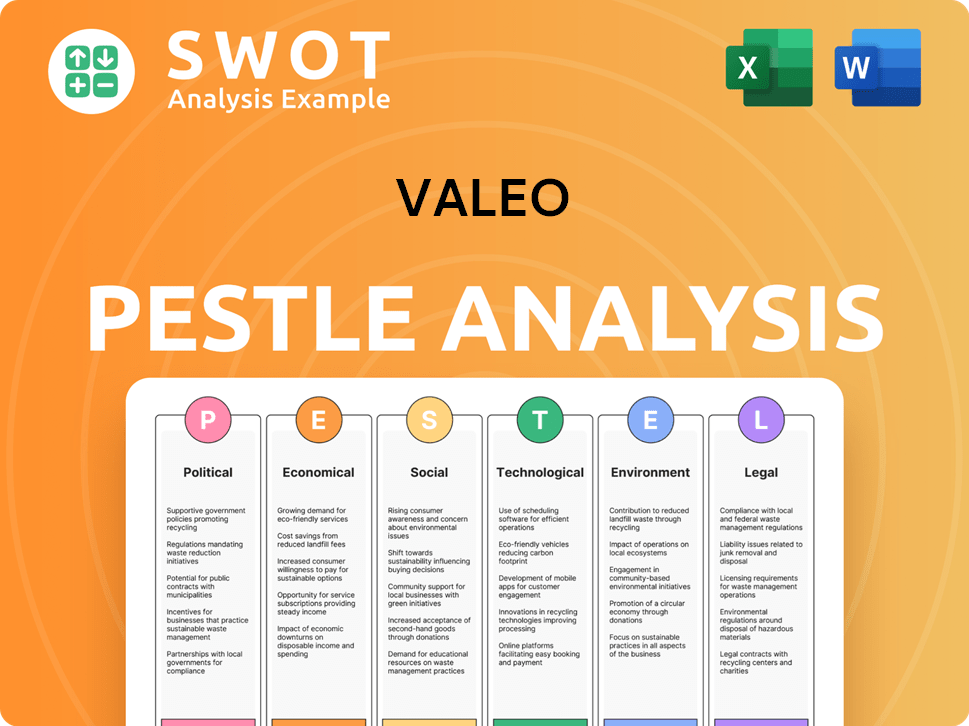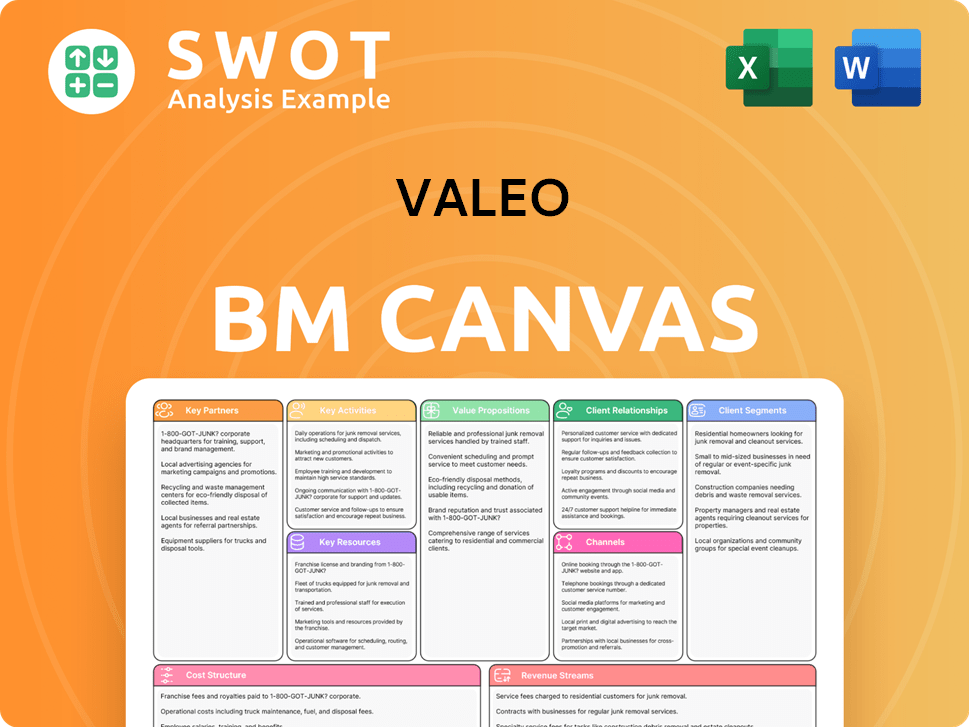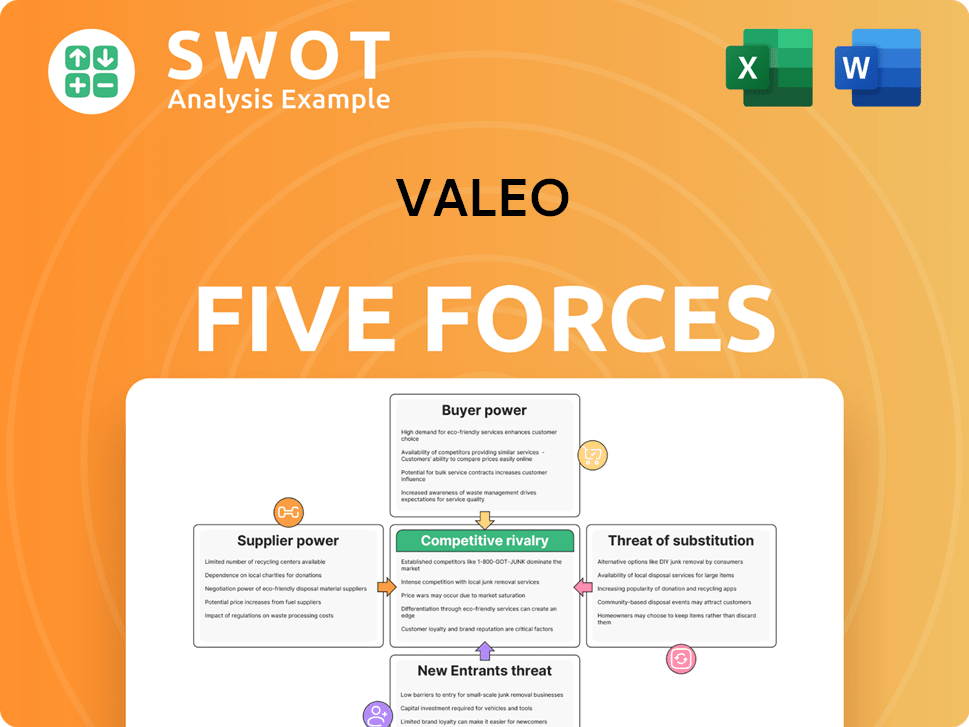Valeo Bundle
Navigating the Automotive Revolution: Who's Challenging Valeo?
The automotive industry is in overdrive, fueled by electrification and autonomous driving, creating a complex battlefield for suppliers. Valeo, a pioneer in automotive technology, is at the forefront of this transformation. But how does this industry giant stack up against its rivals in this fast-paced environment? This analysis dives deep into the Valeo SWOT Analysis, its competitors, and its strategies for continued success.

This exploration of the Valeo competitive landscape will provide a comprehensive Valeo market analysis, examining its industry position and key competitors. We'll dissect Valeo's financial performance in comparison to its rivals, evaluate its strategic partnerships, and assess its ability to navigate the evolving demands of the automotive sector. Understanding Valeo's competitive advantages is crucial for anyone looking to invest in or partner with a leader in the automotive industry.
Where Does Valeo’ Stand in the Current Market?
Valeo maintains a strong market position within the automotive supply industry, particularly in its core segments. The company is a key player in electrification, advanced driving assistance systems (ADAS), and interior comfort. Understanding the Valeo competitive landscape is crucial for assessing its strategic moves and financial health.
The company's primary product lines include powertrain systems for electrification, ADAS technologies, and interior comfort solutions. Its global presence, serving major automotive markets across Europe, Asia, and North America, underscores its significance as a Tier 1 supplier. The Valeo industry position is shaped by its commitment to innovation and adaptation to industry trends.
Valeo's strategic focus on electrification and ADAS aligns with the automotive industry's shift towards sustainable and autonomous mobility. This strategic direction is supported by significant investment in research and development, which reached €2.062 billion in 2023. For a deeper dive into their marketing strategies, consider exploring the Marketing Strategy of Valeo.
While specific market share figures for 2024-2025 are subject to market dynamics, Valeo consistently ranks among the top global automotive suppliers. In 2023, Valeo reported sales of €22.044 billion, demonstrating its significant scale within the industry. This financial performance is a key indicator of its competitive strength.
Valeo has a robust global presence, serving major automotive markets across Europe, Asia, and North America. Its customer segments include all major automakers worldwide, reflecting its role as a key Tier 1 supplier. This broad geographic reach supports its market position.
Valeo's product portfolio includes powertrain systems for electrification (48V to high-voltage), ADAS technologies (sensors, cameras, radar, LiDAR), and interior comfort solutions. These diverse offerings cater to the evolving needs of the automotive industry. The company's innovation in these areas is critical.
R&D expenses reached €2.062 billion in 2023, highlighting Valeo's commitment to innovation. This significant investment allows Valeo to develop cutting-edge technologies and maintain a competitive edge. This investment is a key factor in Valeo's financial performance.
Valeo holds a particularly strong position in areas like ADAS, where it is recognized as a leader in certain sensor technologies. Its focus on electrification and ADAS aligns with industry trends. This strategic focus and investment in R&D contribute to its competitive advantages.
- Strong market position in key automotive segments.
- Significant investment in R&D, especially for electrification and ADAS.
- Global presence and relationships with major automakers.
- Financial health, supported by strong sales figures.
Valeo SWOT Analysis
- Complete SWOT Breakdown
- Fully Customizable
- Editable in Excel & Word
- Professional Formatting
- Investor-Ready Format

Who Are the Main Competitors Challenging Valeo?
The Brief History of Valeo reveals that the company operates in a fiercely contested automotive supply market. Understanding the Valeo competitive landscape is crucial for assessing its market position and future prospects. This landscape is shaped by a mix of direct and indirect competitors, all vying for market share and technological leadership.
Valeo competitors include major Tier 1 automotive suppliers, each with diverse product portfolios and global reach. These companies challenge Valeo through various means, including innovation, pricing, and strategic partnerships. Analyzing the competitive dynamics provides insights into Valeo's strategies and potential vulnerabilities.
The automotive supply market is highly competitive, with several global players vying for market share. Valeo's market analysis reveals a complex interplay of technological advancements, pricing pressures, and strategic alliances. The company faces both direct and indirect challenges from a range of competitors.
Valeo's industry position is directly challenged by several major automotive suppliers. These companies compete across various segments, including powertrain, chassis systems, and automotive electronics. The competition is particularly intense in areas like autonomous driving and electrification.
Bosch is a significant competitor across multiple segments, including powertrain, chassis systems, and automotive electronics. Bosch's vast product range and global reach pose a considerable challenge to Valeo. In 2023, Bosch's automotive sector sales were approximately €61.6 billion.
Continental competes strongly in areas like advanced driver-assistance systems (ADAS), brake systems, and interior electronics. Continental often leverages its software expertise to gain a competitive edge. Continental's automotive technologies division generated sales of approximately €33.8 billion in 2023.
ZF Friedrichshafen is a key rival in driveline and chassis technology, as well as active and passive safety systems. ZF's focus on these core areas makes it a strong competitor. In 2023, ZF's sales totaled over €46.6 billion.
Denso competes across thermal systems, powertrain, and electrification components, particularly in the Asian market. Denso's strong presence in Asia gives it a significant advantage. Denso's consolidated revenue for the fiscal year 2023 was approximately ¥6.8 trillion (about $46 billion USD).
Magna International, with its diverse offerings from complete vehicle manufacturing to seating systems, also presents broad competition. Magna's comprehensive product portfolio makes it a formidable player. Magna's total sales in 2023 were approximately $46.7 billion.
The competitive landscape is shaped by several factors. Valeo's financial performance is directly influenced by its ability to compete effectively. The automotive supplier comparison reveals that each competitor employs different strategies to gain market share.
- Aggressive Pricing: Competitors often use aggressive pricing strategies to win contracts.
- Innovation Cycles: Rapid innovation cycles are essential to stay ahead in the market.
- Brand Recognition: Strong brand recognition with automakers is crucial.
- Distribution Networks: Extensive distribution networks ensure product availability.
- Technological Capabilities: Advanced technological capabilities are a key differentiator.
Valeo PESTLE Analysis
- Covers All 6 PESTLE Categories
- No Research Needed – Save Hours of Work
- Built by Experts, Trusted by Consultants
- Instant Download, Ready to Use
- 100% Editable, Fully Customizable

What Gives Valeo a Competitive Edge Over Its Rivals?
The competitive landscape for Valeo is shaped by its focus on innovation and its extensive research and development (R&D) capabilities. Valeo's strategic moves, especially in electrification and advanced driver-assistance systems (ADAS), are key to its market position. A deep understanding of the Growth Strategy of Valeo is crucial for assessing its competitive edge.
Valeo's competitive advantages are rooted in its technological expertise, particularly in electric powertrains and ADAS. Its investments in these areas have positioned it strongly in the automotive industry's growth sectors. The company's global presence and established relationships with major automakers further enhance its market access and supply chain efficiency.
The company's financial performance and strategic partnerships are also critical factors. Valeo's ability to co-develop solutions with original equipment manufacturers (OEMs) fosters customer loyalty. These advantages are evolving from traditional manufacturing strengths to a more technology-centric approach, leveraging its talent pool of engineers and researchers.
Valeo's leadership in electrification is a significant competitive advantage. The company's 48V systems offer cost-effective solutions for hybridizing vehicles. This positions Valeo strongly in a market that is increasingly focused on emissions reduction and electric vehicle (EV) adoption.
Valeo's expertise in ADAS, especially in sensors and perception software, is another key advantage. Its SCALA LiDAR was the first series-produced automotive LiDAR. This showcases its pioneering spirit and technological prowess in the autonomous driving space.
The company's vast intellectual property portfolio, including numerous patents, strengthens its competitive edge. This protects its innovations and allows it to maintain a leading position in critical automotive technologies. Patents are a key factor in the Valeo competitive landscape.
Valeo's global manufacturing footprint and strong OEM relationships provide significant advantages. This includes economies of scale, efficient supply chains, and enhanced market access. These factors are essential for the company's sustained financial performance.
Valeo's competitive advantages are multifaceted, including technological leadership, a strong global presence, and extensive OEM partnerships. The company's focus on innovation and its R&D capabilities are crucial for its success in the automotive supplier comparison. These advantages are essential for navigating the dynamic market.
- Electrification Technologies: Valeo's 48V systems and other electrification solutions.
- ADAS Technologies: Expertise in sensors, perception software, and LiDAR.
- Intellectual Property: A vast portfolio of patents protecting its innovations.
- Global Presence: Manufacturing footprint and strong OEM relationships.
Valeo Business Model Canvas
- Complete 9-Block Business Model Canvas
- Effortlessly Communicate Your Business Strategy
- Investor-Ready BMC Format
- 100% Editable and Customizable
- Clear and Structured Layout

What Industry Trends Are Reshaping Valeo’s Competitive Landscape?
The automotive industry is undergoing significant transformation, creating both challenges and opportunities for Valeo and its competitors. This evolution is driven by the rise of electric vehicles (EVs), autonomous driving technologies, and connected vehicle systems. These trends necessitate substantial investments in research and development, adaptation of manufacturing processes, and strategic partnerships. A thorough Valeo market analysis reveals the company's position amidst this dynamic landscape.
The company's industry position is influenced by its ability to navigate these shifts while managing risks such as increased competition and potential declines in traditional internal combustion engine component demand. Examining the Valeo competitive landscape, it's clear that success hinges on innovation, strategic agility, and a proactive approach to emerging market segments. For a deeper understanding, consider exploring the Growth Strategy of Valeo.
The automotive industry is experiencing a rapid transition towards electric vehicles (EVs). This shift is driven by environmental concerns and government regulations. Autonomous driving technologies and connected vehicle systems are also key trends. These innovations create new opportunities for automotive suppliers.
One major challenge is the high capital investment required for R&D in new technologies. Intense competition from both established players and new entrants is another hurdle. The potential decline in demand for traditional components poses a significant risk. Adapting manufacturing processes to meet new demands is critical.
The EV market presents a vast opportunity for Valeo's electrification products. The development of autonomous driving creates demand for advanced sensors and software. Vehicle connectivity and data services offer new revenue streams. Strategic partnerships and innovations are key to success.
Valeo is heavily investing in R&D for electrification and ADAS technologies. The company is forming strategic partnerships with tech companies and automakers. Optimizing its industrial footprint to support new product lines is a priority. Valeo aims for around 80% of its original equipment sales to come from technologies contributing to CO2 emissions reduction and enhanced safety by 2025.
Valeo's competitive advantages include its focus on innovation, strategic partnerships, and a diversified product portfolio. The company's commitment to R&D and its global presence enhance its ability to compete. Valeo's strategic focus is evolving towards software-defined vehicles and sustainable mobility solutions.
- Research and Development: Valeo invests heavily in R&D, with spending representing a significant percentage of its revenue.
- Strategic Partnerships: Collaborations with technology companies and automakers are crucial for innovation.
- Product Portfolio: A diversified portfolio allows Valeo to cater to various market segments.
- Global Presence: Valeo's operations span across multiple countries, providing a broad market reach.
Valeo Porter's Five Forces Analysis
- Covers All 5 Competitive Forces in Detail
- Structured for Consultants, Students, and Founders
- 100% Editable in Microsoft Word & Excel
- Instant Digital Download – Use Immediately
- Compatible with Mac & PC – Fully Unlocked

Related Blogs
- What are Mission Vision & Core Values of Valeo Company?
- What is Growth Strategy and Future Prospects of Valeo Company?
- How Does Valeo Company Work?
- What is Sales and Marketing Strategy of Valeo Company?
- What is Brief History of Valeo Company?
- Who Owns Valeo Company?
- What is Customer Demographics and Target Market of Valeo Company?
Disclaimer
All information, articles, and product details provided on this website are for general informational and educational purposes only. We do not claim any ownership over, nor do we intend to infringe upon, any trademarks, copyrights, logos, brand names, or other intellectual property mentioned or depicted on this site. Such intellectual property remains the property of its respective owners, and any references here are made solely for identification or informational purposes, without implying any affiliation, endorsement, or partnership.
We make no representations or warranties, express or implied, regarding the accuracy, completeness, or suitability of any content or products presented. Nothing on this website should be construed as legal, tax, investment, financial, medical, or other professional advice. In addition, no part of this site—including articles or product references—constitutes a solicitation, recommendation, endorsement, advertisement, or offer to buy or sell any securities, franchises, or other financial instruments, particularly in jurisdictions where such activity would be unlawful.
All content is of a general nature and may not address the specific circumstances of any individual or entity. It is not a substitute for professional advice or services. Any actions you take based on the information provided here are strictly at your own risk. You accept full responsibility for any decisions or outcomes arising from your use of this website and agree to release us from any liability in connection with your use of, or reliance upon, the content or products found herein.